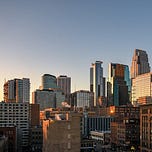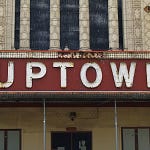Consistent Commitment
Minneapolis needs people who are committed to its revitalization. From picking up trash and removing graffiti to attracting new businesses and jobs, everything requires consistent, hard work.
I was excited to interview Adam Duininck for several reasons. First, as Uptown explores creating its own Business Improvement District, there are important lessons to learn from the years of experience that have shaped the Downtown Improvement District. Second, while I’ve heard about Adam and the Downtown Council for years, what exactly they do was often a mystery to me.
In our conversation, Adam makes the case for why someone like me—a newsletter writer working from home—should care about the fate of downtown. Any resident concerned about the city’s health and rising property taxes has a stake in seeing downtown rebound. While the share of tax revenue from commercial properties has shifted over time, they remain essential to the success of both Minneapolis and the state.
We talked about what Rochester is getting right, given its growth, and the challenges facing Minneapolis. We also discussed the possibility of a new arena for the Timberwolves, how crime is being addressed, and why it's vital for local leaders to actively support business investment here.
There is a Clock
The city needs solutions. Thirty-five people working every day to promote a city of this size seems modest. It’s easy—especially in an election year—to focus on the negatives. But Minneapolis must move forward. We need to build momentum for improving the city before we lose more businesses and residents to the suburbs and other states.
That doesn’t mean all hope is lost if we can’t bring new corporate headquarters and hundreds of employees back downtown every day. But it does mean we need creative, consistent effort to find new avenues for growth.
Our conversation didn’t reveal one simple solution. For example, converting commercial space to residential is a promising idea—but it won’t happen quickly, and it won’t work everywhere. It will take multiple, simultaneous efforts to first stabilize the city and then build on what we already have.
As we vet candidates, it’s worth asking: What actions will they take to welcome business? More is needed than a few small business grants or rent assistance for art installations. Minneapolis must change how it is perceived. It needs a mayor and city council willing to work together to compete in what’s shaping up to be an unpredictable and chaotic economic landscape.
More information about the Downtown Council is available on their website.
Better Minneapolis is reader-supported. Please consider becoming a paid member today.
Below is a summary outline of our conversation.
1. Overview of Organizations
Roles of Minneapolis Downtown Council and Downtown Improvement District.
Structure, staffing (approx. 35 employees), and funding sources (membership dues, event sponsorships, and some public funds).
2. Economic Impact & Downtown’s Significance
Why downtown matters to the entire city and region.
Commercial property tax implications for all residents.
Historical tax share shift from commercial to residential.
3. Challenges Post-Pandemic
Decline in office attendance and building values.
Uneven downtown recovery compared to other cities.
Vacant office buildings and tenant consolidation trends.
4. Public Safety & Perceptions
Safety Ambassador program and Nicollet security pilot.
Behavioral and outreach services (e.g., downtown storage program, community spaces).
Perception gap vs. reality of safety downtown.
5. Events & Tourism
Role in producing/promoting events (e.g., Aquatennial, Taste of Minnesota).
Positive impact of sporting events (e.g., Timberwolves playoffs) on local economy.
6. Business & Development Policy
Downtown Council as a pro-business advocate.
Opposition to local-only policy moves (e.g., Uber/Lyft pay mandate, rent control).
Emphasis on regional coordination.
7. Real Estate & Conversions
Adaptive reuse of office buildings into residential (e.g., Northstar Center, Groove Lofts).
Discussion of tax credits for redevelopment ("CUB" credit).
Investment examples like the Kickernick Building.
8. Improvement District Model
DID’s evolution and services (cleaning, safety, outreach).
Advice for Uptown’s consideration of a similar model.
Measurable impact through detailed data tracking.
9. Civic Engagement & Elections
Importance of civic participation and election reforms.
Duininck supports shifting municipal elections to even years.
Skepticism of current caucus system.
10. Visitor Recommendations
Favorite downtown spots: Mill City Museum, Nicollet Mall, Peavey Plaza, local restaurants.
Encouragement to visit and even do staycations.
Hope for revitalizing iconic spaces like the downtown post office.















Share this post